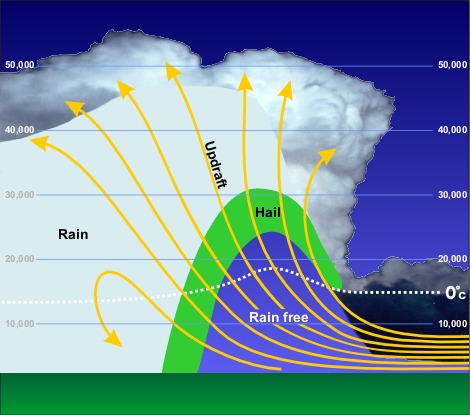Published: August 2025 | Reading Time: 8 minutes
What is Hail Alley Colorado Springs and Why It’s Ground Zero for Severe Storms
Hail Alley Colorado Springs sits at the epicenter of North America’s most dangerous hail zone. This region experiences more frequent and severe hailstorms than anywhere else in the country, with Colorado Springs recording over 50 hail days annually in this notorious Hail Alley Colorado Springs corridor.
The unique geography of the Colorado Front Range creates perfect conditions for supercell thunderstorms. When warm, moist air from the Gulf of Mexico collides with cool, dry air masses over the Rocky Mountain foothills, the result is explosive storm development that produces devastating hail events.
Hail Alley Colorado Springs: Homeowner’s Guide to Storms and Insurance
Published: August 2025 | Reading Time: 8 minutes
Meta Description: Hail Alley Colorado Springs guide for homeowners facing severe storms. Learn historical disasters, storm science, and changing insurance coverage in 2025.
The unique geography of the Colorado Front Range creates perfect conditions for supercell thunderstorms in Hail Alley Colorado Springs. When warm, moist air from the Gulf of Mexico collides with cool, dry air masses over the Rocky Mountain foothills, the result is explosive storm development that produces devastating hail events across Hail Alley Colorado Springs neighborhoods.
Historical Timeline of Catastrophic Hail Alley Colorado Springs Events
July 11, 1990 – The Denver Metro Disaster
- Hail Size: Golf ball to softball (4+ inches)
- Damage: $625 million (1990 dollars)
- Impact: Over 47,000 vehicles damaged, widespread roof destruction
- Significance: Changed how insurance companies view hail risk in Colorado
May 8, 2017 – The Spring Storm Surge
- Hail Size: Tennis ball sized (2.5 inches)
- Damage: $2.3 billion across Colorado
- Impact: Colorado Springs saw thousands of insurance claims throughout Hail Alley Colorado Springs
- Notable: Marked beginning of increased insurance scrutiny
August 6, 2018 – The Evening Assault
- Hail Size: Baseball sized (2.75 inches)
- Damage: $1.4 billion statewide
- Impact: Severe damage to Hail Alley Colorado Springs neighborhoods
- Result: Many insurers began policy restrictions
June 19, 2023 – The Recent Reminder
- Hail Size: Ping pong to golf ball (1.5-2 inches)
- Damage: $800 million in metro area
- Impact: Triggered new wave of insurance policy changes
- Warning: Prompted current coverage limitations
April 27, 2024 – The Spring Surprise
- Hail Size: Quarter to golf ball sized
- Damage: $400 million locally
- Significance: Latest major event driving 2025 insurance changes

The Science Behind Hail Alley Colorado Springs Storm Formation
Geographic Factors
Elevation Advantage for Storms: Hail Alley Colorado Springs sits at 6,035 feet elevation, where atmospheric instability creates ideal hail formation conditions. The thin air allows hailstones to grow larger before melting during their descent.
Rocky Mountain Convergence: The Front Range acts as a natural launching pad for severe weather. Orographic lifting forces air masses upward, creating the vertical motion necessary for supercell development.
Temperature Contrasts: Dramatic temperature differences between mountain peaks and valley floors fuel storm intensity. These contrasts can exceed 40°F within short distances.
Storm Development Process
- Morning Heating: Solar radiation heats the ground
- Afternoon Instability: Rising air creates cumulus clouds
- Supercell Formation: Rotating updrafts develop
- Hail Growth: Ice pellets cycle through freezing zones
- Storm Maturity: Hailstones reach maximum size
- Descent: Gravity overcomes updraft strength
Climate Change and Increasing Hail Severity
Recent research indicates climate change is intensifying hailstorms in Hail Alley Colorado Springs. Warmer surface temperatures provide more energy for storm development, while changing jet stream patterns alter storm tracks through Hail Alley Colorado Springs communities.
Key Changes Observed:
- Larger average hailstone size
- Longer duration storms
- More frequent supercell development
- Extended hail season (March through October)
Insurance Industry Response: Hail Alley Colorado Springs Coverage Changes in 2025
Major Policy Modifications
Higher Deductibles: Many insurers now require percentage-based hail deductibles ranging from 2% to 5% of dwelling coverage. For a $400,000 home, this means $8,000 to $20,000 out-of-pocket costs.
Separate Hail Deductibles: Some companies implement separate wind/hail deductibles in addition to standard deductibles, effectively doubling homeowner costs for storm damage.
Coverage Limitations: New policies may include:
- Actual Cash Value depreciation for roofs over 10 years
- Limited coverage for cosmetic damage
- Reduced coverage for detached structures
- Exclusions for certain roofing materials
Companies Leaving Colorado Market
Several national insurers have reduced their Hail Alley Colorado Springs presence:
State Farm: Limited new policy writing in Hail Alley Colorado Springs high-risk zip codes
Allstate: Increased rates by 20-30% for existing customers
Farmers: Implemented strict underwriting guidelines
Liberty Mutual: Requires roof inspections for policies over $300,000
Non-Renewal Trends
Insurance companies are non-renewing policies after hail claims, particularly:
- Homes with multiple claims in 5-year periods
- Properties with older roofing systems
- Houses in historically high-damage neighborhoods
Protecting Your Hail Alley Colorado Springs Home
Immediate Actions
Roof Assessment: Have your roof professionally inspected annually. Look for loose or damaged shingles, compromised flashing, and granule loss.
Impact-Resistant Materials: Consider upgrading to Class 4 impact-resistant shingles, which can reduce insurance premiums and provide better protection.
Gutter Maintenance: Clean and secure gutters regularly. Hail damage often starts with compromised drainage systems.
Landscape Planning: Plant trees strategically to provide natural wind breaks without creating falling hazards.
Documentation Strategies
Pre-Storm Photography: Maintain current photos of your home’s exterior, focusing on roofing, siding, and windows.
Inventory Updates: Keep detailed records of personal property with receipts and photos.
Quick Response Planning: Know your insurance company’s claim reporting process and have contact information readily available.
What to Do After Hail Damage
Immediate Steps (First 24 Hours)
- Safety First: Check for structural damage before entering your home
- Document Everything: Take extensive photos and videos
- Prevent Further Damage: Cover broken windows and holes in roofing
- Contact Insurance: Report claims within required timeframes
- Keep Receipts: Save all temporary repair and lodging expenses
Working with Contractors
Get Multiple Bids: Obtain at least three written estimates from licensed contractors
Verify Credentials: Check Colorado contractor licensing and Better Business Bureau ratings
Avoid Door-to-Door Solicitors: Be wary of contractors who appear immediately after storms
Insurance Direct Pay: Consider contractors who work directly with insurance companies
Future Outlook for Hail Alley Colorado Springs Homeowners
Predicted Trends
Increasing Premiums: Industry analysts predict 15-25% annual increases through 2027
Market Consolidation: Fewer insurers will write policies in high-risk areas
Government Intervention: Colorado may implement residual market programs for high-risk properties
Technology Solutions: Satellite monitoring and AI claim processing will become standard
Adaptation Strategies
Self-Insurance Options: Consider higher deductibles with emergency savings funds
Risk Mitigation Investments: Impact-resistant materials may provide better long-term value than lower premiums
Market Shopping: Annual policy shopping will become essential as company appetites change
Community Solutions: Neighborhood-wide mitigation efforts may influence insurance availability
Conclusion: Preparing for Hail Alley Colorado Springs Reality
Living in Hail Alley Colorado Springs means accepting hail risk as part of mountain life. The combination of perfect storm conditions, climate change intensification, and insurance market changes requires proactive homeowner strategies throughout Hail Alley Colorado Springs.
Success in Hail Alley Colorado Springs depends on understanding the science behind severe weather, maintaining appropriate insurance coverage, and investing in property protection measures. While insurance companies adapt their business models to manage catastrophic losses, homeowners must adapt their protection strategies accordingly.
The historical pattern is clear: major hailstorms will continue impacting Hail Alley Colorado Springs. The question isn’t if the next major event will occur, but when. Prepared homeowners who understand both the meteorological realities and insurance landscape changes will be best positioned to weather these storms financially and physically.
Key Takeaway: Hail Alley Colorado Springs impact will intensify, making proactive preparation and insurance strategy more critical than ever for protecting your home investment.
External Resources:
- National Weather Service Hail Safety
- Colorado Division of Insurance Consumer Guide
- Insurance Institute for Business & Home Safety
Related Articles:
- Colorado Springs Weather Patterns and Home Protection
- Impact-Resistant Roofing Materials Guide
- Filing Insurance Claims After Hail Damage
Image Alt Text Suggestion: “Hail Alley Colorado Springs neighborhood damage after severe storm showing broken windows and damaged roofing”

